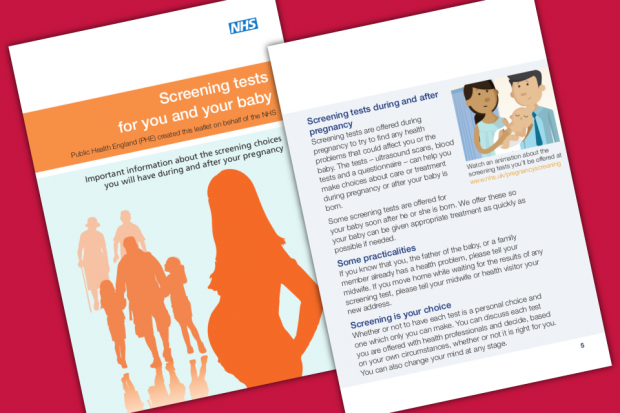
Back in March 2019 we wrote about our plans to move antenatal and newborn screening into the digital age. We asked colleagues from local antenatal and newborn screening services to complete a survey to give us your thoughts.
I’m delighted to say we got a fantastic response, with 85 screening services providing feedback. Massive thanks to all of you who took the time to let us know what you think about this important work.
A quick recap
As we explained in our recent digital information opportunities ahead blog, Public Health England (PHE) has started work to support the NHS to deliver more screening information to the public digitally rather than using physical leaflets. This is because:
- it’s part of the government’s ‘digital by default’ commitment
- we want to meet public expectations for digital information
- digital information can be more engaging and better tailored to the individual
- it’s easier and quicker to keep up to date
- we can save money that could be better used elsewhere
We want to start delivering the changes during the financial year from 1 April 2020 to 31 March 2021. It’s obviously vital we do this in a collaborative way that reduces, rather than increases, inequalities around screening offers and uptake.
The survey was an important first step in looking at how we can do this.
Findings
Use of the current leaflet
The vast majority of maternity departments give out our Screening Tests For You and Your Baby (STFYAYB) leaflet to all pregnant women. Six services said they give it to some women and one said they do not use it at all. Those only giving it to some women said they hand it out to anyone not able to use the electronic version or who prefers to have a physical copy.
Feedback from women
Just under half of services had feedback, either formal or informal, on the STFYAYB leaflet. There was a wide range of views.
At one end of the spectrum, some services said their local pregnant women felt the leaflet had the right amount of information and was easy to understand. In some local surveys, 100% of women said they were happy with the leaflet.
At the other end, quite a few services stated that most women do not read the leaflet in full as so much information is given in one go.
Some women inaccurately thought the section about Down’s Syndrome, Edwards and Patau’s syndrome looked at offering an invasive test. Others felt the leaflet looks a bit old-fashioned.
Many were somewhere in the middle. For example, one response was that “some women do not read it, some love it and some remember it from previous pregnancies”.
Feedback from midwives
Over half of services had asked local midwives what they thought of STFYAYB.
Many said midwives, especially those who were newer qualified or who do not routinely deal with screening, find the leaflet really useful as a prompt during discussions with women.
Many midwives appreciated having the translations and easy read versions. But the common view was that many women mislay the leaflet and, though some feel it is really useful, others think it is too long and comes across as boring.
Local information about screening
Out of the 85 responses, 13 said they have antenatal and newborn screening information on their website. This mostly seemed to be links to national information on GOV.UK and NHS.UK. Five services had developed their own smartphone app, and 5 had created their own local screening leaflet.
For services that already provide information electronically, or that plan to do this:
- 16 said the reason was a local trust policy to go paper-free
- 4 said it was what women expected
- 2 wanted more local control over screening information
One important reason for services pointing women to digital information early in pregnancy is that they said the STFYAYB leaflet is given too late for women to make an informed choice about screening.
Information preferences of pregnant women
Seven services responded to the question about whether they had carried out research on the preferences of pregnant women about how they receive screening information.
Only one said they sometimes send screening information by email if this was requested. A few services stated women had expressed a preference for more online information but another said women “do not want any more information on their phone”.
Taking STFYAYB digital

This was the million dollar question, of course: would you be happy for us to change Screening Tests For You and Your Baby to a digital-only version?
Interestingly, 46 people said ‘yes’ and 39 said ‘no’. But there was a huge amount of similarity in what people said.
The overwhelming feeling seemed to be that, while almost everyone accepted the need and benefit of moving to more digital information, it was vital to consider the needs of women who would not be able to access it. This would almost certainly still require some printed leaflets to be available.
A typical comment was:
I think it is the way forward, however worried about the groups that do not speak English, no smart phone or access to internet. Hard copies are sometimes good as you know women are getting the information.
How and when women should receive information
There were lots of suggestions about how women should be told about digital screening information. It’s clear there is not a one-size-fits-all approach.
Some thought a handout with the website address could be given to women at the booking appointment, or by the GP. Others thought text or email would be better (though there was concern about how this would work and who would be responsible for keeping accurate records). For services where women can self-notify of pregnancy, it was suggested that a link could be provided as part of this process.
Only 7 people said the best time to give the information was at the booking appointment. Most felt it should be provided before this: “this would allow the woman time to digest the information and enable questions to be answered at first appointment”.
One response said:
An app or portal is much more exciting than a leaflet. As soon as the woman finds out she is pregnant that’s when she wants information, not 7 to 10 weeks later at booking.
Possible disadvantages of digital information
A vital part of the survey was to get the views of screening services about people who could be disadvantaged by a move to digital information. Almost everyone responded to this question and we got some very helpful feedback.
Groups identified as being potentially disadvantaged included women who:
- have language or cultural barriers (such as immigrants and asylum seekers)
- are vulnerable due to age, mental health or domestic issues
- do not have smartphones or easy access to the internet (examples included women who are homeless, in prison or from the travelling community)
- have learning disabilities or literacy issues
- lack IT skills or confidence
- have visual impairments
- experience social deprivation
- live in rural areas where internet access is poor
Final comments
A couple of comments were great summaries and very representative of responses as a whole:
As long as the digital version is sent safely without jeopardising personal data and is available to all in different languages I cannot foresee this being an issue. A link needs to be sent prior to the booking interview appointment as this will make the process more streamlined.
We definitely need to head in this direction, but need to ensure equality in terms of access and level of information available. Ease of access also needs to be a big factor; because you’ve got access on your phone, does not mean you know how to use it.
There were also some great suggestions about how videos and interactive content could be developed to make digital information more engaging and interesting.
To those who asked whether we’ll be asking women for their views, the answer is definitely ‘yes’. We’ll be running focus groups over the next couple of months.
Next steps
We’ll be using the information from the survey to inform our plans. We’ve taken particular note of the need to come up with ways of meeting the needs of women who will not get on well with digital information. Our plan is to work with voluntary sector groups with expertise in this area on the best solutions. I’m sure part of this will involve still providing some printed leaflets, as many of you suggested.
We will be contacting those of you who kindly said you would be happy to be involved further. We’re also looking for areas to pilot the new approach so please get in touch through the PHE Screening helpdesk if you’d be interested.
PHE Screening blogs
PHE Screening blogs provide up to date news from all NHS screening programmes. You can register to receive updates direct to your inbox, so there’s no need to keep checking for new blogs. If you have any questions about this blog article, or about population screening in England, please contact the PHE screening helpdesk.